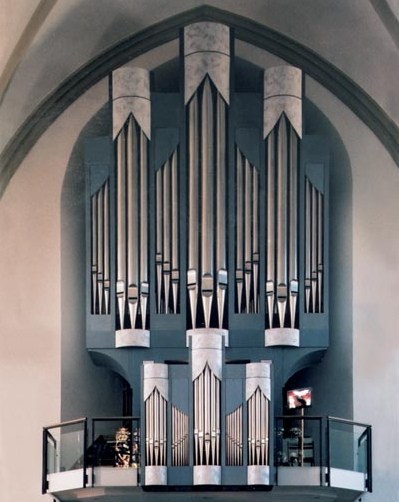St. Anna’s church, Twistringen
 The Becker organ at St. Anna’s makes a statement and is clearly inspired by the aesthetics of Gottfried Silbermann. This consistency of aesthetics is reflected in, among other things, the high wind pressure, its widest-possible lips, and the central position of the organ within the church. The Principal stops are uniformly scaled so that their sound is homogenous, solemn, and transparent. The comparatively high proportion of Principal stops (21 out of 42) follow Silbermann’s idea of the perfect Plenum sound. They complete the overall sound, achieving highlights, and providing sparkle. This is particularly true for the Principals in the Positive section of the organ which go up to 1 1/3-foot and 1-foot pitch. Due to their respective Principals and mixtures, each of the four sections of the organ has its own personality, but these differences become less important when stops from different sections are played together, making the instrument’s overall sound extremely cohesive. The 12-stop Hauptwerk is based on a 16-foot Bordun (see Freiberg Cathedral) that is matched by the Großmixtur. The Oberwerk is similarly rich in stops. This opulent equipment makes the instrument extremely versatile, equally adapted for chorale fantasias in the North German baroque tradition requiring two equally strong organ sections, or Late-Romantic works demanding a rich 8-foot sound - they all can be performed with authentic sound. And yet the organ at St. Anna’s is anything but a Silbermann clone: its tuning is based on 440 Hz and only slightly unequal, and its manual and pedal ranges are those commonly used today. Also, none of G. Silbermann’s instruments has a Rückpositiv; instead his large organs are (or were) equipped with classical French Positive stops contained in the Brustwerk. In the case of St. Anne’s organ, the Silbermann Brustwerk was “transferred” to a Rückpositiv with a rich proportion of mutation stops as well as a Krummhorn, offering many options for solo expression. Blending North German baroque and French romantic traditionsTrumpets and Krummhorn at St. Anna’s have been handcrafted in such a way that French genres such as Grand Jeu, Récit de Cromorne, Basse de Trompette, or Tierce en Taille can be played authentically. These stops are completed by the Cornet V, which is mounted high behind the Hauptwerk façade, the full Cornett III in the Oberwerk, and the Cornet décomposé in the Rückpositiv. These can all be used both as solo stops and within a reed chorus. The 8-foot and 4-foot pedal trumpets are so powerful that each on its own can easily express a chorale line played against a Plein Jeu on the manuals. In general, what makes Silbermann’s concepts special are the “French imports” in his organs, and this is particularly true for this Becker organ. Silbermann’s idea of merging seemingly incompatible principles, together with the quality of Becker’s pipe voicing, make for an instrument of great versatility and fascinating homogeneity. The composition of mixtures repeating at low pitch level makes it easy to hear the individual voices in polyphonic music. The mixtures also blend well with the reeds inspired by French organ-building traditions. |
For example, the organ’s Plenum sound is brilliant yet discrete, enabling the player to interpret 19th and 20th century works.
On hearing or playing the organ for the first time, one is struck by its high vocal quality. Similar to the characteristics of Italian instruments, the singing quality of the core stops seems more important than their function as the foundation of the overall sound. This can be felt only if several stops are played together or in a chord. The aesthetics of the Italian art of organ-building can be found at every turn, as in the previously mentioned complete Principal chorus, which even includes a 1-foot Principal. New opportunities in connection with a renovation project In 1988, St. Anna’s church had to be closed for six years for major reconstruction and time-consuming asbestos removal, affecting also the existing organ. Fortunately, the circumstances provided enough time for planning a new instrument.What followed was an extensive opinion-forming process that identified the need for an organ suitable for a broad spectrum of musical styles, instead of being “so-so” for all kinds of music. Since the instrument was meant to last for generations, it was decided not to indulge in personal preferences. Several field trips to similar settings in Saxony strengthened the resolve to take inspiration from Silbermann. Master organ builder Michael Becker immediately agreed to embark on the adventure. Far from being a hodgepodge, his instrument is extremely versatile, and the sound it produces is anything but tedious; on the contrary, it stands out for its cohesion. All this is thanks to the great expertise of Michael Becker and his team, including pipecrafter Günter Lau. The project was initiated, planned to the last detail, and supervised by Dresden Silbermann expert Frank Harald Greß. In his extensive 1704 “Description of a large new organ at the church of Sts. Peter and Paul here in Görlitz,” Christian Ludwig Boxberg praised Casparini’s Sun Organ in words that could easily be applied to the sound of this Becker organ: "It is incomparable, pleasant, delicate, rare, and splendid. No wild crying, just homogenous sound coming from the entire instrument. It could not be better. With regard to the scaling of the Principals, the pipes are crafted in such a fashion as required for homogeneity both in terms of the character and intensity of tone. Their overall sound is silvery and pleasant.” The organ at St. Anna’s is now 17 years old and has been the topic of many conversations. Its genuine and engaging nature easily convinces and amazes both listeners and organists. Again and again, it has proven its transformative powers as it proclaims its important message. |
